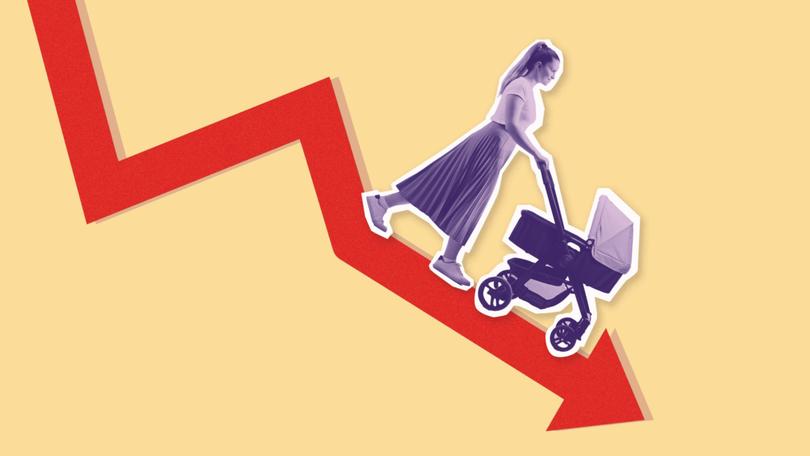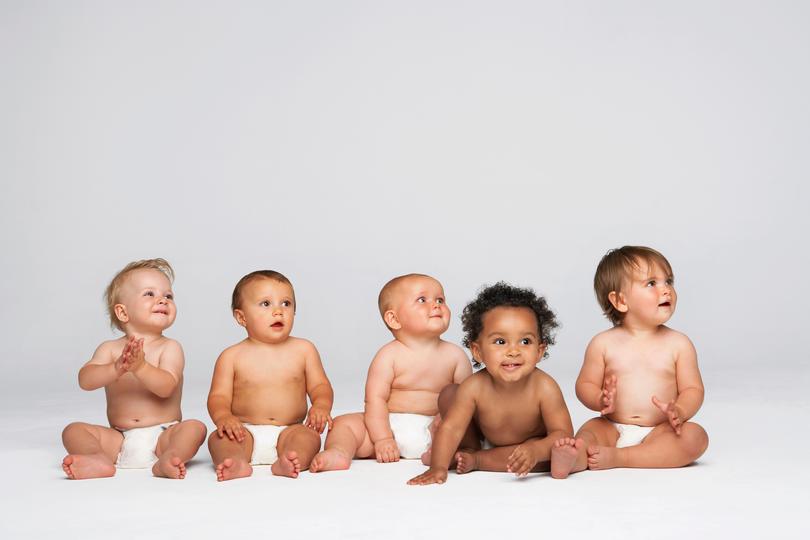THE ECONOMIST: Can the rich world escape its baby crisis?

Three decades ago, when women now entering their 40s became fertile, East Asian governments had reason to celebrate. If a South Korean woman behaved in the same way as her older compatriots, she would emerge from her childbearing years with 1.7 offspring on average, down from 4.5 in 1970.
Across the region, policymakers have brought down teenage pregnancies dramatically. The drop in birth rates, which occurred over the span of a single generation, was a stunning success. That was until it carried on. And on.
A South Korean woman who is now becoming fertile will have on average just 0.7 children over her childbearing years if she follows the example of her older peers. Since 2006 the country’s government has spent $US270 billion ($407b), or just over 1 per cent of GDP a year, on baby-making incentives such as tax breaks for parents, maternity care and even state-sponsored dating. Officials would love even just a few of the “missing” births back.
Sign up to The Nightly's newsletters.
Get the first look at the digital newspaper, curated daily stories and breaking headlines delivered to your inbox.
By continuing you agree to our Terms and Privacy Policy.What began in East Asia is increasingly true elsewhere, too. Among rich countries, only Israel has enough children to stop its population from shrinking, and in most places, birth rates are falling. The great and the good are worried. “A nation’s strength”, warns Emmanuel Macron, France’s president, “lies in its ability to generate a dynamic birth rate.” Elon Musk, owner of SpaceX, Tesla and X, predicts the end of civilisation.
Almost every rich country is considering increasing its pro-natal efforts, as are many middle-income ones. In January Mr Macron launched a campaign to “demographically rearm” France (his weapons of choice: fertility tests and maternity leave). Donald Trump has promised “baby bonuses for a new baby boom” if he wins re-election.
China, long famous for its one-child policy, now offers incentives ranging from child care to tax breaks in order to encourage parents to have three children. Will such policies be enough to avert demographic catastrophe?

Existing pro-natal measures tend to benefit professional mothers. Across Europe, for instance, most cash incentives are earnings-related — in the form of maternity payments and income-tax breaks — rather than being means-tested, which would direct them to less affluent types. In Singapore parents get lump-sum payments, but only for house deposits, which are beyond poor families. Norway offers mothers nearly a year off work, with pre-pregnancy incomes provided by the state, as well as plenty of child care.
Even before Mr Macron’s rearmament, France spent big on fertility. Since the turn of the millennium it has disbursed 3.5-4 per cent of GDP a year on a mixture of handouts, services and tax breaks, meaning it has the highest pro-natalist spend in the OECD club of mostly rich countries.
But in 2022 fewer children were born in the country than at any point since the second world war. Similarly, South Korea has little to show for its pro-natal expenditure: no study has been published in a reputable journal showing a single additional birth resulting from the billions of dollars spent.
Researchers did once find a small but enduring rise in the birth rate owing to policies in Nordic countries, which mix maternity leave with generous child care. In the 1980s officials expected the impact of these egalitarian schemes to grow with time, as social attitudes adjusted to make life easier for working mothers.
But women in Denmark, Norway and Sweden who started having children in 1980 turned out to have fewer than those who started a decade earlier. In fact, it is expectations among potential mothers that seem to have adjusted: as women became used to generous benefits, the extra support seems to have become insufficient to prompt extra births.
Some schemes that try to re-engineer society also backfire. In the OECD extending maternity leave prompts women to delay having their first child, and to have fewer over their lifetime, possibly because the increased time off means more workplace stigma. Heterosexual couples in which a man takes paternity leave are less likely to have another child, perhaps because some men find themselves less suited to hands-on parenting than they imagined.
Governments that simply put cash in the pockets of new parents, and allow them to decide on their own priorities, may have more luck. Guy Laroque of University College London and co-authors find that French income-tax breaks are likely to increase the average number of children a woman has. Monthly payments in Israel will probably have similar effects, according to Alma Cohen of Tel Aviv University and colleagues.
But not only do such policies have a relatively small impact, they are also fabulously expensive, as lots of cash goes to parents who would have had children regardless of the financial incentives available. Each child that resulted from Child 500+, in the years from the Polish financial-bonus scheme’s introduction in 2016 to 2019, cost $1 million. In France each extra child over the past decade has cost twice that.
Breeding like pandas
The thinking behind such policies dates back to the entrance of women into the workforce en masse, which happened at around the same time as birth rates began to fall. Gary Becker, a Nobel-prizewinning economist, suggested in the 1960s that the best way to consider children is as goods that parents purchase according to how many they can afford, both in terms of time and money. Easing the burden of a career and expanding household budgets should thus boost childbearing, he concluded.
Yet the reality of the fall in fertility is more complex. For the most part, it does not reflect changing habits among professional women, as would be suggested by Becker’s theories.
Instead, birth rates have collapsed because young women are not having as many children. In 1960 American women had on average 3.6 children. In 2023 they had 1.6. Remarkably, women aged 30 and above are having more children. It is only women under the age of 24 who are having fewer.
Moreover, the decline among under-24-year-olds is itself concentrated among teenagers. More than half the drop in America’s total fertility rate is explained by women under the age of 19 now having next to no children. Around a third of the missing births would have been unplanned, and most of these would have been to women on low incomes.
As Kathryn Edin, a sociologist at Princeton University who has been interviewing poor women in America since the 1990s, notes: “When I first started, these women I met were having their first kids at 16, 17. Now there is something wrong if you have got a child under 25.” Similarly, in Britain women born in 2000 had half as many children before they were 20 as those born in 1990. Unlike their rich counterparts, these women will probably not compensate with more children later in life.

Meanwhile, there is little evidence that middle-class women wish they had many more children, which would at least suggest they might be open to official persuasion. Today, at the age of 24, college-educated American women want on average 2.2 children — roughly as many as previous generations.
They will now have these children a little later than before, with the first arriving at the age of 30, compared with 28 in 2000. Although trends suggest they will still fall short of their ideal family size, the gap may be the same as women in previous generations, who missed the target by an average of 0.25 children.
Therefore attempting to encourage middle-class women to have more children is unlikely to be successful. Economists think such women more confidently plan and predict their future than their less well-off peers. Their plans tend to involve children only after a predictable path of college, work and marriage, meaning they are less likely to react to changes in financial circumstances.
Most existing pro-natal policies are trying to do something much more difficult than merely restoring previous fertility patterns. They are trying to persuade women to have more children than they would ideally have, and are doing so with sums that are small compared with their lifetime earnings.
Younger and working-class women probably offer policymakers the best chance of higher birth rates. Indeed, some programs are now beginning to explicitly target them. Zhejiang, a province on China’s eastern border, is offering newly married couples a lump sum, but only if the bride is below the age of 25. In Russia women who have a child before they turn 25 will soon be exempt from income tax.
Hungary offers a similar benefit to mothers who have their first child before 30 — one of only two policies in Viktor Orban’s pro-natal push that economists at the Central European University think has created additional births. Although small families are becoming more common almost everywhere, women who start young still tend to have more children over their lifetime, which is why Messrs Orban, Putin and Xi are focusing on them.
Other evidence shows working-class women’s fertility is more responsive to financial circumstances than that of their richer peers. In America and Europe birth rates among poorer women fell sharply after the Global Financial Crisis of 2007-09, for instance. College-educated women were more likely to stick to their plans and have children anyway.
That is in part because professionals delay having children until they have the resources required to outsource a lot of child-rearing to nannies and nurseries, making them less reliant on state provision, which was cut back as governments sought to reduce public spending.
Even existing rich-world pro-natal policies have outsize effects on low-income women. State-run childcare services often represent a standard of child care that mothers would not otherwise be able to obtain. Data from Israel’s Bureau of Statistics suggest that from 1999 to 2005 the country’s child subsidy resulted in a greater fertility boost for low-income women than their richer peers. In Norway and Finland, the modest boost that pro-natalist cash gave to birth rates was driven by women with the lowest incomes. When French middle-class families’ child tax credits were cut in half in 2014, by contrast, there was no change in their birth rate.
Missing storks
Cash transfers are simply a bigger deal to poor households. In January, Rx Kids, a nonprofit run by a group of doctors, started one of America’s first unconditional cash transfer programmes in Flint, Michigan, one of the country’s most impoverished cities. Under the program, every mother is entitled to $7,500, which is handed out in instalments from when she first falls pregnant to her child’s first birthday.
For the average enrolled local mother, who has an income below $10,000, that is a 75 per cent increase in her annual income. The program’s first aim is to alleviate child poverty, says Mona Hanna-Attisha, who runs the charity, but local officials also hope it will boost the town’s birth rate, too.
At a get-together for participants, young mothers laugh when asked if $7,500 would be enough of an incentive to encourage them to have another child; after all, low-income American households typically spend $20,000 in a baby’s first year of life. But such money may well have an impact at the margin. As one mother puts it, extra cash “might make me keep one I wasn’t sure I was going to have”. In America, poor women are much more likely than middle-class women to cite financial hardship as a reason for an abortion.
Birth rates in America, Europe and East Asia have fallen far enough that not even appealing to women whose fertility reacts most strongly to incentives is going to stop populations from shrinking.
But by 2050 more than three-quarters of the world’s women will be reproducing below replacement rate, according to forecasts published by the Lancet, a medical journal. Even if governments are unable to turbocharge birth rates overnight, they will not stand idle. Pro-natal policies are only going to gather further momentum.
Will governments other than the likes of Hungary’s and Russia’s start to target incentives at younger, poorer women? Childbearing produces positive externalities for society. As the sclerotic economies of East Asia are discovering, shrinking populations mean less innovation, manpower and tax revenue. Parents are expected to shoulder most of the cost of children, which is a particular burden for poorer ones. And political calculation may come into play. Few governments have lost votes as a result of making handouts more generous.
But some factors should give politicians pause. The extra children produced by such policies will probably not turn into the productivity-boosting professionals that governments envision. Only 8 per cent of the children of American-born non-college-educated parents are themselves expected to obtain a bachelor’s degree, and during their adult life the average high-school graduate boosts the public finances by less than a tenth of the net contribution of a college graduate.
Therefore the financial benefits of pro-natal policies that aim at working-class women would probably be overwhelmed by their costs, given the expense associated with even well-targeted programs. The best hope for such policies would lie in boosting the life outcomes of extra children. Early evidence from trials such as the one in Flint and COVID-19 assistance programmes suggests that cash transfers lift children’s performance in early schooling and improve access to health care.
Another consideration is the morality of such interventions. Policymakers sought to break the norm of young motherhood for a reason. Each year a woman goes without childbearing, her expected lifetime earnings rise. A first-time American mother in her mid-30s will earn more than twice what she could be expected to have earned had she her first child aged 22. Women who give birth aged 15 to 19 are more likely to develop health problems; their first children are more likely to drop out of middle school and to grow up without having both parents at home.
In Flint many mothers express regret they did not manage to “get things sorted” before having children. “Hang on,” says one outside a community centre, “the idea is that I get paid just enough to make me have another kid? But that’s all that changes? Where doing it (raising a kid) right, later on, it’s all me? That doesn’t seem right.” The 26-year-old mother of three leans back and laughs.
Originally published on The Economist
